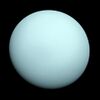Astronomy:NASA Uranus orbiter and probe

A Uranus orbiter and probe is a mission concept for study of the planet Uranus. It was first recommended to NASA in 2011 by its Planetary Science Decadal Survey 2013–2022.[1] [2]
NASA evaluated in 2017 twenty different mission designs submitted by the scientific community, considering mission trades, trajectories, and the technology required for specific objectives. Because of planet position and alignments, Neptune was dropped in favor of Uranus.[3] If funded, the proposed mission would launch in the 2020s with launch-windows of 21 days every year.[3]
Overview
The survey listed the Uranus orbiter and probe as the third priority for a Flagship mission after what would become the Mars 2020 rover and an orbiter to Europa, the Europa Clipper. The SLS rocket has been proposed by Boeing as a launch vehicle for the Uranian probe.[4][5]
Although a chemical propulsion mission to Uranus is possible, solar electric propulsion (the NEXT ion engine) is an option for the first portion of the journey because it allows a larger spacecraft mass. An early mission concept, Herschel Orbital Reconnaissance of the Uranian System (HORUS), proposed to use three advanced Stirling radioisotope generators to power an orbiter for the Uranian system.[6] The committee narrowed the mission concepts to three scenarios.[7][8][9]
| Flyby and atmospheric probe |
Orbiter and atmospheric probe |
Orbiter without atmospheric probe | |
|---|---|---|---|
| Science goals | Interior structure, composition | Interior structure, composition, rings, moons, magnetospheres |
Interior structure, composition, rings, moons, magnetospheres |
| Science payload | 3 instruments (50 kg [110 lb]) | 3 instruments (50 kg [110 lb]) | 15 instruments (50 kg [110 lb]) |
| Propulsion | Chemical and solar electric propulsion within the inner Solar System region |
Chemical | Chemical |
| Flight time | 10 years | 15 years | 15 years |
| Time in orbit | Flyby | 3 years | 3 years |
| Power | 4 MMRTG 425 W |
4 MMRTG 376 W |
5 MMRTG 470 W |
The atmospheric probe element of this mission would study the vertical distribution of cloud-forming molecules, thermal stratification, and wind speed as a function of depth. The 2010 mission design envisioned a probe of 127 kg (280 lb), less than half that of the Galileo atmospheric probe.[2] A later design study suggested that the probe could be as small as 30 kg (66 lb) in mass and about 0.5 m (20 in) in diameter.[10]
There is also a study that recommended a medium-class concept for the New Frontiers program to develop such an orbiter for Uranus.[11]
See also
- Uranus mission proposals
- MUSE
- Oceanus (New Frontiers-class proposal of the 2010s)
- ODINUS
- Uranus Pathfinder (ESA M-Class proposal of the 2010s)
References
- ↑ Vision and Voyages for Planetary Science in the Decade 2013–2022
- ↑ 2.0 2.1 Hubbard, William B. (Revision 6/3/2010). Ice Giants Decadal Study, NASA SDO-12345. Retrieved June 22, 2020.
- ↑ 3.0 3.1 Uranus and Neptune Orbiter and Probe Concept Studies, Ice Giants Decadal Study (dead link)
- ↑ Chris Gebhardt (20 November 2013). "New SLS mission options explored via new Large Upper Stage". NASASpaceFlight. http://www.nasaspaceflight.com/2013/11/new-sls-options-new-large-upper-stage.
- ↑ "Space Launch System Exploration, Science, Security". http://www.boeing.com/assets/pdf/defense-space/space/sls/docs/sls_mission_booklet_jan_2014.pdf.
- ↑ Smith, R.M.; Yozwiak, A.W.; Lederer, A.P.; Turtle, E.P. (2010). "HORUS—Herschel Orbital Reconnaissance of the Uranian System". 41st Lunar and Planetary Science Conference (1533): 2471. Bibcode: 2010LPI....41.2471S.
- ↑ It’s time to explore Uranus and Neptune again — and here's how NASA could do it. Loren Grush, The Verge. 16 June 2017.
- ↑ Revisiting the ice giants: NASA study considers Uranus and Neptune missions. Jason Davis. The Planetary Society. 21 June 2017.
- ↑ NASA Completes Study of Future ‘Ice Giant’ Mission Concepts. NASA TV. 20 June 2017.
- ↑ K. M. Sayanagi, R. A. Dillman, A. A. Simon, et al. " Small Next-generation Atmospheric Probe (SNAP) Concept", LPI 2083 (2018): 2262. Long version of paper: Space Sci Rev, 216, 72 (June 10, 2020) Small Next-Generation Atmospheric Probe (SNAP) Concept to Enable Future Multi-Probe Missions: A Case Study for Uranus. Retrieved June 22, 2020.
- ↑ THE CASE FOR A URANUS ORBITER, Mark Hofstadter et al.


